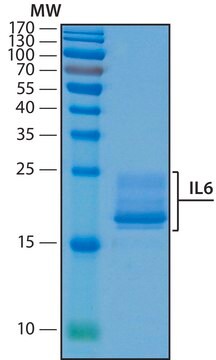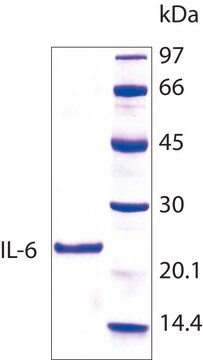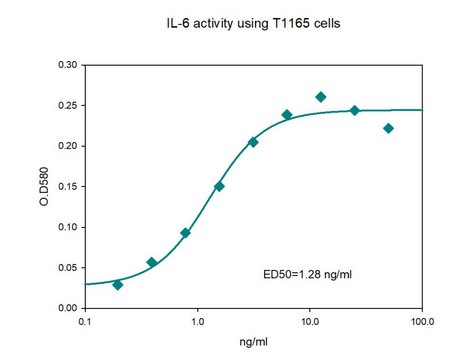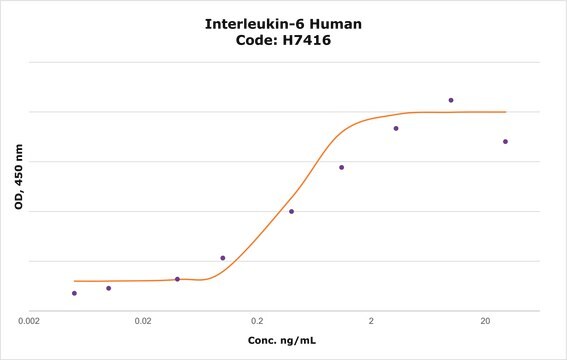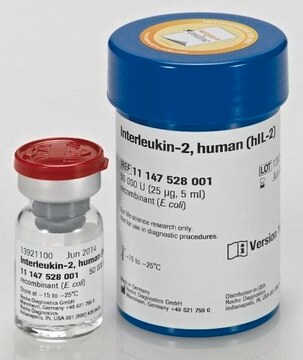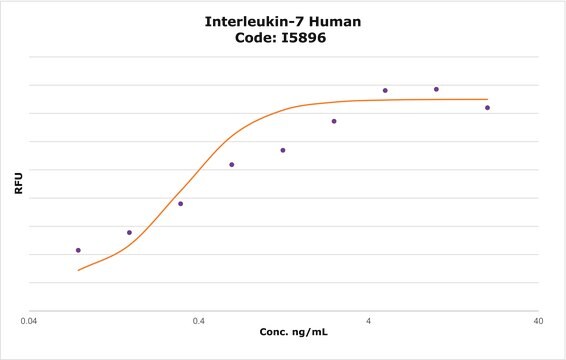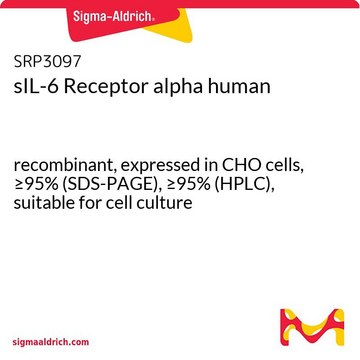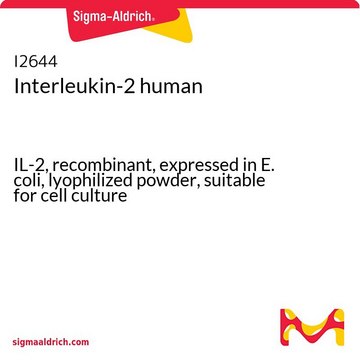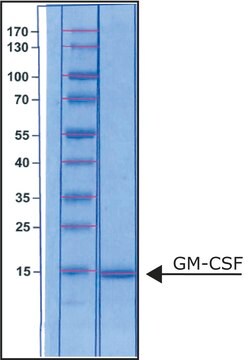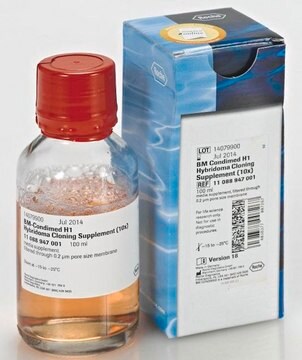11138600001
Roche
Interleukin-6, human (hIL-6)
recombinant (E. coli)
Synonym(s):
hIL-6, interleukin-6 human
Sign Into View Organizational & Contract Pricing
All Photos(1)
About This Item
UNSPSC Code:
12352207
Recommended Products
biological source
human
Quality Level
recombinant
expressed in E. coli
Assay
>98% (SDS-PAGE)
form
solution
potency
<0.01 ng/mL EC50
mol wt
20,600 Da
packaging
pkg of 200,000 U (2 μg, 1 ml)
manufacturer/tradename
Roche
storage condition
avoid repeated freeze/thaw cycles
technique(s)
cell culture | hybridoma: suitable
impurities
<0.1 EU/μgtested (LAL test)
UniProt accession no.
storage temp.
−20°C
Gene Information
human ... IL6(3569)
General description
Interleukin-6, human (hIL-6), is produced in E. coli and purified by standard chromatographic techniques.
Specificity
Recombinant IL-6, human is effective on mouse and human cells.
IL-6, a 26 kD protein, also known as B-cell stimulatory factor 2 (BSF-2, BCDF), interferon-β2 (IFN-β2), hybridoma/plasmacytoma growth factor (H(P)GF), and hepatocyte-stimulating factor is produced by many cell types (e.g., T-cells, monocytes, fibroblasts, endothelial cells). IL-6 induces the terminal maturation of activated B-cells into antibody-producing cells (B-cell differentiation activity. The hepatic acute phase response is induced by IL-6 (hepatocyte-stimulating activity). It was shown that IL-6 and IL-3 act synergistically to support the proliferation of hematopoietic stem cells (hemapoietic activity), however, IL-6 does not have antiviral activity, although it has been called IFN-β2. High affinity receptors for IL-6 are found on many cell types.
IL-6, a 26 kD protein, also known as B-cell stimulatory factor 2 (BSF-2, BCDF), interferon-β2 (IFN-β2), hybridoma/plasmacytoma growth factor (H(P)GF), and hepatocyte-stimulating factor is produced by many cell types (e.g., T-cells, monocytes, fibroblasts, endothelial cells). IL-6 induces the terminal maturation of activated B-cells into antibody-producing cells (B-cell differentiation activity. The hepatic acute phase response is induced by IL-6 (hepatocyte-stimulating activity). It was shown that IL-6 and IL-3 act synergistically to support the proliferation of hematopoietic stem cells (hemapoietic activity), however, IL-6 does not have antiviral activity, although it has been called IFN-β2. High affinity receptors for IL-6 are found on many cell types.
Application
Recombinant IL-6, human, is a growth factor for murine and human B-cells. It can be used to replace feeder cells in the preparation of murine and human hybridomas.
Biochem/physiol Actions
Interleukin-6 participates in several pleiotropic functions in various types of cells through its specific receptor (IL-6-R). It has been suggested that interleukin-6 may participate in the interaction between neuroendocrine and immune system by activating adrenocorticotropic hormone secretion. It has also been reported that IL-6 stimulates the bonding of receptor (IL-6-R) with a non-ligand-binding membrane glycoprotein, gp130.
Quality
Purity: 95% pure as determined by HPLC or SDS-PAGE [Endotoxin level: <0.1 EU/μg (LAL-test), <10 EU/ml (LAL-test).
Note: 1 EU corresponds to 0.1 ng
Note: 1 EU corresponds to 0.1 ng
Sequence
Chain Length 184 AA
The primary structure of recombinant human IL-6 is identical to that of natural human IL-6 (one polypeptide chain, 184 amino acids), however, it contains an altered sequence within the first 15 amino-terminal amino acids.
Unit Definition
EC50 definition: The amount of hIL-6 that is required to support half-maximal stimulation of cell proliferation (MTT cleavage) with 7TD1 cells (1 unit equals <0.01 ng).
Physical form
Solution, filtered through 0.2 μm pore size membrane.
Preparation Note
Working concentration: 10 to 100 U/ml (0.1 1 ng/ml)
10 to 100 U/ml (0.1 to 1 ng/ml)
A concentration of 100 U/ml (1 ng/ml) is recommended for the preparation of B-cell hybridomas
Working solution: Dilute the concentrated IL-6 solution (200,000 U/ml) with PBS or culture medium containing 1 mg/ml BSA [or HSA (human serum albumin)] or 1 to 10% serum.
Storage conditions (working solution): -15 to -25 °C
Store the solution in aliquots at -15 to -25 °C.
Note: Avoid repeated freezing and thawing.
10 to 100 U/ml (0.1 to 1 ng/ml)
A concentration of 100 U/ml (1 ng/ml) is recommended for the preparation of B-cell hybridomas
Working solution: Dilute the concentrated IL-6 solution (200,000 U/ml) with PBS or culture medium containing 1 mg/ml BSA [or HSA (human serum albumin)] or 1 to 10% serum.
Storage conditions (working solution): -15 to -25 °C
Store the solution in aliquots at -15 to -25 °C.
Note: Avoid repeated freezing and thawing.
Reconstitution
Dilute the concentrated IL-6 solution (200,000 U/ml) with PBS or culture medium containing 1 mg/ml BSA [or HSA (human serum albumin)] or 1 to 10% serum.
Analysis Note
Specific activity/EC50: >1 x 108 U/mg, <0.01 ng/ml (hIL-6, NIBSC, interim standard, 88/514), at least the same specific activity (EC50) compared to the indicated standard is guaranteed.
Other Notes
For life science research only. Not for use in diagnostic procedures.
Storage Class Code
12 - Non Combustible Liquids
WGK
nwg
Flash Point(F)
does not flash
Flash Point(C)
does not flash
Choose from one of the most recent versions:
Already Own This Product?
Find documentation for the products that you have recently purchased in the Document Library.
Customers Also Viewed
H Kikutani et al.
Journal of immunology (Baltimore, Md. : 1950), 134(2), 990-995 (1985-02-01)
Stimulation of human B lymphoblastoid cell lines, CESS and SKW6-CL4 with BCDF induced an increase in IgG- and IgM-secreting cells, as well as a slight increase in IgG and IgM expression on their respective surfaces. Biosynthetic labeling demonstrated that BCDF
R Bazin et al.
Journal of immunological methods, 116(2), 245-249 (1989-01-17)
The addition of macrophage feeder cells or conditioned medium has been shown to increase the yield of murine hybridomas obtained after the fusion of myeloma cells and activated B lymphocytes. It has been shown recently that the conditioned medium contains
B cell growth and differentiation factors.
K Brooks et al.
Methods in enzymology, 116, 372-379 (1985-01-01)
Y Naitoh et al.
Biochemical and biophysical research communications, 155(3), 1459-1463 (1988-09-30)
In order to assess the effect of interleukin-6 on the hypothalamo-pituitary-adrenal axis, we administered recombinant human interleukin-6 to conscious, freely-moving rats. The intravenous injection of interleukin-6 significantly increased the plasma level of adrenocorticotropic hormone 30 min after the injection in
J Gordon et al.
Immunology today, 8(11), 339-344 (1987-01-01)
The need to activate B lymphocytes on antigen challenge is tempered by the requirement that the response is terminated when the challenge has been negotiated. Regulation is probably mediated via the interaction of soluble factors with surface receptors. Here, John
Our team of scientists has experience in all areas of research including Life Science, Material Science, Chemical Synthesis, Chromatography, Analytical and many others.
Contact Technical Service